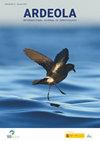No Evidence of Deliberate Egg Soiling in the Pied Avocet Recurvirostra avosetta to Improve Camouflage
IF 1.2
4区 生物学
Q2 ORNITHOLOGY
引用次数: 0
Abstract
Summary. Predation is one of the main causes of nest failure in birds. In order to overcome this, many species lay cryptic eggs, which enhances camouflage through either background matching or shape disruption, among other mechanisms. Despite this, ground-nesting birds still suffer high nest predation rates. One possibility to alleviate this could be to soil the eggs with particles of material surrounding nests, improving the camouflage. Indeed, it has been suggested that egg soiling is a mechanism of egg protection, but it remains to be demonstrated whether egg soiling is a strategy used by birds or is an unintentional by-product after incubating adults enter nests with dirty feet, legs and/or plumage. In this study, we analysed images from infra-red camera traps placed beside Pied Avocet Recurvirostra avosetta nests, in which we had previously cleaned dirty eggs and provided mud with which the adults might have soiled the eggs, and we found no evidence of deliberate egg soiling in this case. There was a slight improvement (not statistically significant) in the camouflage of soiled avocet eggs in comparison to clean eggs, but only in one of two studied nesting sites in which the eggs were more soiled. Although egg soiling may result in improved camouflage, future studies should address its potential costs to establish why it has not apparently evolved as a deliberate strategy to improve egg camouflage in nesting shorebirds.—Ramo, C., Castro, M., Pérez-Hurtado, A., Martín, N., Rendón, M.A., Amat, J.A. & Liñán-Cembrano, G. (2023). No evidence of deliberate egg soiling in the Pied Avocet Recurvirostra avosetta to improve camouflage. Ardeola, 70: 169-184. Resumen. La predación es una de las causas principales del fracaso de nidos de aves. Para superar esto, muchas especies ponen huevos crípticos, lo que mejora el camuflaje mediante similitud con el fondo o alteración en la percepción de las formas, entre otros mecanismos. A pesar de esto, particularmente las aves que nidifican en el suelo sufren altas tasas de predación de nidos. Una posibilidad para aliviar esto consistiría en ensuciar los huevos con partículas del material que rodea los nidos, lo que mejoraría el camuflaje. De hecho, se ha sugerido que el ensuciamiento es un mecanismo de protección de los huevos, pero queda pendiente de demostración si el mismo es una estrategia usada por las aves o es un resultado colateral no intencionado como consecuencia de que las aves entren a incubar con las patas o el plumaje sucios. En este estudio analizamos imágenes de cámaras-trampa infrarrojas colocadas junto a nidos de avoceta común Recurvirostra avosetta, en las que previamente habíamos limpiado los huevos que estaban sucios y suministrado barro con el que los adultos podrían ensuciar los huevos. No encontramos evidencia de que el ensuciamiento de huevos sea una estrategia deliberada usada por las avocetas. El camuflaje de los huevos mejoró ligeramente (aunque no fue estadísticamente significativo) cuando estaban sucios, pero solo en uno de los dos sitios estudiados, en el que los huevos estaban más sucios. Aunque el ensuciamiento mejore el camuflaje, los estudios futuros deberán considerar los costes potenciales para determinar por qué aparentemente no ha evolucionado como una estrategia deliberada para mejorar el camuflaje de huevos en aves limícolas.—Ramo, C., Castro, M., Pérez-Hurtado, A., Martín, N., Rendón, M.A., Amat, J.A. y Liñán-Cembrano, G. (2023). No hay evidencia de un ensuciamiento deliberado de los huevos en la avoceta común Recurvirostra avosetta para mejorar el camuflaje. Ardeola, 70: 169-184.没有证据表明在斑鳄梨中故意弄脏卵以改善伪装
总结。捕食是鸟类筑巢失败的主要原因之一。为了克服这一点,许多物种会产下隐卵,通过背景匹配或形状破坏等机制来增强伪装。尽管如此,地面筑巢的鸟类仍然遭受着很高的捕食率。缓解这种情况的一种可能是在巢穴周围撒上一些物质颗粒,从而改善它们的伪装。事实上,有人认为弄脏鸡蛋是一种保护鸡蛋的机制,但弄脏鸡蛋是鸟类使用的一种策略,还是孵化的成年鸟带着脏脚、腿和/或羽毛进入巢穴后无意产生的副产品,还有待证明。在这项研究中,我们分析了放置在Pied Avocet Recurvirostra avosetta巢穴旁的红外摄像机陷阱的图像,我们之前已经清理了脏蛋,并提供了成虫可能弄脏蛋的泥土,我们没有发现在这种情况下故意弄脏蛋的证据。与干净的鸡蛋相比,脏的鳄梨蛋的伪装有轻微的改善(没有统计上的显著性),但只有在两个被研究的鸡蛋更脏的筑巢地点之一。虽然弄脏蛋可能会改善伪装,但未来的研究应该解决它的潜在成本,以确定为什么它没有明显地进化成一种有意识的策略来改善筑巢的滨鸟的蛋伪装。雷默,C。卡斯特罗,M, Perez-Hurtado, A。,马丁,N,瑞,硕士何晓卫j & Linan-Cembrano g(2023)。没有证据表明花鳄梨故意弄脏卵以改善伪装。生物医学工程学报,21(3):559 - 564。Resumen。网址:predación网址:网址:网址:网址:网址:网址:predaciónPara superesto,就像特别的ponenhuevos crípticos一样,将mejjora el camuflaje调解为类似于alteración和percepción de la formas,进入其他机制。一个pesar de esto,特别是在一个特殊的地方,在一个特殊的地方,在一个特殊的地方,在一个特殊的地方,在一个特殊的地方,在predación de nidos。unpossible para aliviar to consistiría en ensuciar los huevos con partículas del material que rodea los nidos, lo que mejoraría el camuflaje。他说:“我认为,在我们的工作机制中,我们的工作机制是建立在我们的工作机制中,我们的工作机制是建立在我们的工作机制中,我们的工作机制是建立在我们的工作机制中,我们的工作机制是建立在我们的工作机制中,我们的工作机制是建立在我们的工作机制中,我们的工作机制是建立在我们的工作机制中。我们的研究分析工作室imágenes de cámaras-trampa infrarrojas colocadas junto a nidos de avoceta común在研究分析后,我们的研究发现了新的发现habíamos limpiado los huevos通过管理发现了新的发现,发现了新的发现podrían enciar los huevos。没有任何证据表明,在战略审议期间,没有任何证据表明,没有任何证据表明,在战略审议期间,没有任何证据表明,没有任何证据表明,在战略审议期间,没有任何证据表明。El camuflaje de los huevos mejoró ligigeramente (unque no fue estadísticamente significant) cuando establish sucios, pero solo en uno de los dos sitios estudeos, en El que los huevos established más sucios。“独特的、独特的、独特的、独特的”、“独特的”、“独特的”、“独特的”、“独特的”、“独特的”、“独特的”、“独特的”、“独特的”、“独特的”、“独特的”、“独特的”、“独特的”、“独特的”、“独特的”、“独特的”、“独特的”、“独特的”、“独特的”、“独特的”、“独特的”、“独特的”、“独特的”、“独特的”。-Ramo, C, Castro, M, psamez - hurtado, A., Martín, N., Rendón, m.a., Amat, J.A. y Liñán-Cembrano, G.(2023)。没有确切的证据表明,没有证据表明,没有证据表明,没有证据表明,没有证据表明,没有证据表明,没有证据表明,没有证据表明,没有证据表明,没有证据表明,没有证据表明,没有证据表明,没有证据表明,没有证据表明,没有证据表明,没有证据表明,没有证据表明,没有证据表明,没有证据表明,没有证据表明,没有证据表明,没有证据表明,没有证据表明,没有证据表明。生物医学工程学报,21(3):559 - 564。
本文章由计算机程序翻译,如有差异,请以英文原文为准。
求助全文
约1分钟内获得全文
求助全文
来源期刊
CiteScore
2.30
自引率
6.20%
发文量
16
审稿时长
>12 weeks
期刊介绍:
Ardeola: International Journal of Ornithology is the scientific journal of SEO/BirdLife, the Spanish Ornithological Society. The journal had a regional focus when it was first published, in 1954. Since then, and particular during the past two decades, the journal has expanded its thematic and geographical scope. It is now a fully international forum for research on all aspects of ornithology. We thus welcome studies within the fields of basic biology, ecology, behaviour, conservation and biogeography, especially those arising from hypothesis-based research. Although we have a long publication history of Mediterranean and Neotropical studies, we accept papers on investigations worldwide.
Each volume of Ardeola has two parts, published annually in January and July. The main body of each issue comprises full-length original articles (Papersand Review articles) and shorter notes on methodology or stimulating findings (Short Communications). The publication language is English, with summaries, figure legends and table captions also in Spanish. Ardeolaalso publishes critical Book Reviewsand PhD-Dissertation Summaries; summarising ornithological theses defended in Spain. Finally there are two Spanish-language sections, Ornithological News; summarising significant recent observations of birds in Spain, and Observations of Rare Birds in Spain, the annual reports of the Spanish Rarities Committee.

 求助内容:
求助内容: 应助结果提醒方式:
应助结果提醒方式:


